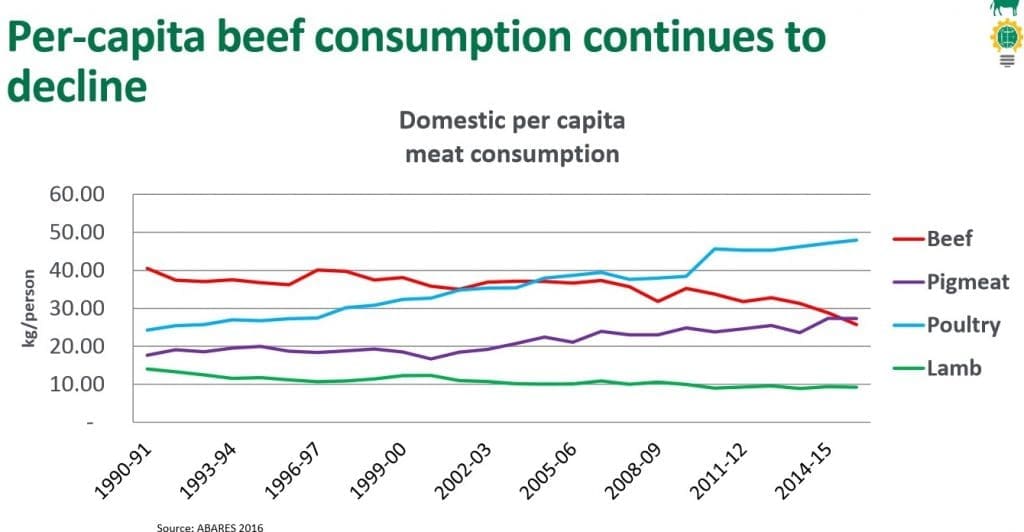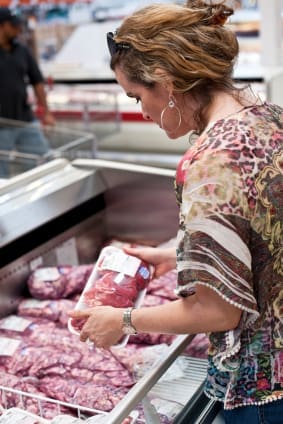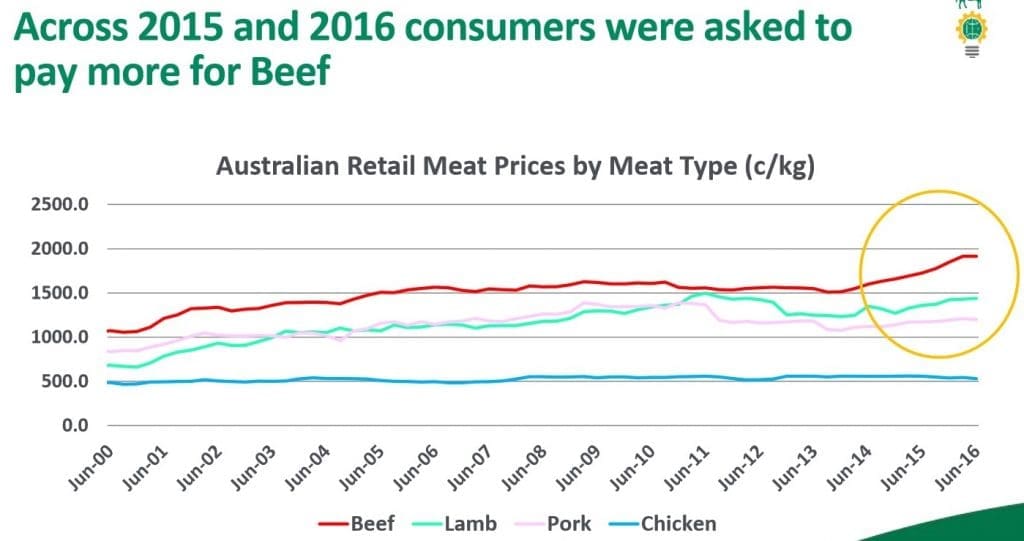WHILE beef is now as much as four times the price of chicken on the domestic retail market, the value of beef sales (price x volume) continued to grow strongly last year, stakeholders attending this week’s Global Markets Forum in Brisbane heard.
MLA’s group marketing manager for Australia, Andrew Howie said the beef marketing challenge in the domestic space currently was quite complex, due to price rises and a host of other factors.
As the graph published here shows, retail beef prices have been on a steady incline, almost doubling over 15 years and showing a dramatic rise since 2014. That’s created the distinct risk of push-back from typical consumers. In contrast chicken price (blue line) is more or less a flat line, at around $5/kg.
“In some ways that looks like a challenge for beef – and it has been – but an important factor is that the rise that’s been seen is really only being driven by a relatively small number of (steak) cuts from the carcase,” Mr Howie said.
Steak cuts (classified as rump steak and above) had risen 30pc in retail price since the start of 2015, while a wide range of non-steak cuts that sit beneath that had only risen by much smaller amounts, he said.
“That actually offers a fantastic opportunity in both food service and retail, especially when we consider whole carcase utilisation, in trying to educate consumers that there’s more to beef than just a scotch fillet or a sirloin,” Mr Howie said.

Per capita consumption of beef, however, continues to pose a concern (see second graph above), with beef plotted in red continuing to trend down. That’s especially apparent since 2008, around about the time the Global Financial Crisis took hold.
“That erosion in consumer sentiment saw them run in droves to attractively priced chicken (blue line), and to a lesser extent, pork (purple) – and they have stayed there,” Mr Howie said.
Lamb, in contrast with beef, has shown much steadier per-capita consumption over the past 15 years, despite the higher prices being paid.
The domestic beef market was unique in that its competitors are other proteins such as chicken and pork – not beef from other suppliers, Mr Howie told the forum. The domestic market returned to longer-term averages last year, accounting for about 30pc of all Australian beef production, after falling to about 25pc during the previous year of record production.
Beef’s headwinds
Beef continued to face a range of headwinds in the domestic market, Mr Howie said. These included:
- Price is now almost four times as high as the key protein competitor, in chicken
- Australia’s population mix continues to change, which is having an influence over per capita consumption. Australia remains the second largest consumer of meat (all species) in the world, just behind the US, and within that, we rate as the fifth largest world consumers of beef. That means any immigrants that come to Australia that eat less beef than the average are going to drag the figure down.
- Australians are taking greater interest in their health. Health is much more complex than simply nutrition, and covers a whole range of factors, and is more than the ‘food’ side, taking on board where the animals are from and how they are raised.
- Consumers are increasingly time-poor, and are looking less at food as an ingredient, and more towards meal solutions. That’s evident in the rapid increase in pre-prepared ready-to-cook, or ready-to-heat meals in supermarkets. Consumers are looking at solutions to get food on the plate faster.
- Increasing number of consumer influencers, through social media and other channels.
Value continues to grow
But in amongst all that ‘doom and gloom’, there were some really positive messages for beef, Mr Howie said.

Andrew Howie
Value (price by volume) has grown in the domestic market on average for the past six years. 2016, from a value perspective, was a really strong year – averaging close to $50 million per week in retail sales across Australia.
“That represents a great story, in that for the past couple of years, stretching all the way back to the Beef 2015 event in Rockhampton, we were warning that tight times lay ahead in terms of supply, and the industry would be asking Australians to pay more for beef,” he said.
“Recent independent Neilsen statistics showed that Australian consumers have paid more for beef, and are continuing to do so. There are issues with livestock supply problems than continue to plague the industry, but the domestic market remains pretty buoyant,” Mr Howie said.
“We’re now starting to see retail prices come off a little bit, and hopefully they will settle somewhere slightly above where they were before all this started – and will show that consumers are prepared to continue to pay a little more for their beef.”
Retail, food service strategies
The increasing cost of raw material was stimulating new and innovative ways to keep red meat options on-shelf in retail settings, Mr Howie said.
“Gross profit margins have certainly been under pressure in retail, and we’ve had to work hard with retailers to ensure they maintain shelf space for red meat, reinforcing the importance of our protein to their business.”
 Cost of raw material had also been a big issue in the food service sector.
Cost of raw material had also been a big issue in the food service sector.
“Many food service operators use a per-meal pricing structure, working out what it’s going to cost to get a meal on a plate. Often when gross profit is under pressure, they tend to look at other proteins in that space. So finding new and innovative cuts that can meet their cost expectations has been a new and innovative challenge for us – but it’s one that is having a huge amount of impact,” Mr Howie said.
Part of this was about promoting a range of Masterpiece Cuts, to fill food service needs at competitive price points.
Mr Howie told the Global Markets forum that beef tended to bear ‘most of the brunt’ of the bad news that emerged about meat protein, in areas like World Health Organisation classifications.
“When conversations come out about red meat being a possible carcinogen, most of the flack tends to go towards beef. Add to that some confusion among consumers about how to use different cuts and how they perform, and there is a lot of health education taking place to help consumers better understand how to turn specific cuts into a meal.
With time-poor consumers looking for quick, convenient meal solutions, MLA had developed a range of ‘Fridge to fork in 15 minutes’ recipe ideas, which were resonating well with consumers.
“Traditionally, some beef has been associated with hearty, slow-cooked meals, so there’s a great opportunity to convince consumers that beef is also a good choice in quick-and-easy meals,” Mr Howie said.
“A lot of consumers tend to think that beef is in fact more expensive than it is – driven by that prime steak pricing issue mentioned earlier. But there’s a huge range of cuts from mince, dice, strips, brisket which are well within the typical householders budgets.”
“There’s opportunities for us to close the gap around these price perceptions.”
“It’s about giving the consumer reasons to pay more – to give them the confidence to cook each product as it should be – setting beef as an aspirational product at whatever level – whether that be ‘Cook your best-ever bolognaise with beef’, or ‘Lasagne’s better with beef,’ there’s opportunity to reiterate the whole spectrum of cuts from the carcase,” he said.
“We want consumers to be really proud of choosing beef. We want them celebrating that moment when they pick it up off the shelf; we want them choosing beef because they see it as the king of meats, and we need to invoke in our promotions the pride the consumer feels when they choose our product.”


Article by MLA suggests lamb consumption has remained relatively unchanged from 1990 which is in direct contrast to beef which has lost market share. The MLA graph indicates beef had dropped by 30% of the whilst the consumption of lamb remained steady, in direct contrast ABARE figures published in 2010 suggest lamb and mutton consumption in 1990 , was 22 kilograms and by 2010 this had gone down to 10.1 kg my understanding is we are eating 8.5 kg a 62% fall in consumption. Who is right??
MLA states that domestic beef consumption accounts for about 30% of total annual production.However this number does not reconcile with statistics produced by the ABS.According to the ABS total beef production in calendar 2016, excluding calves and offal was 2,103.097 tonnes cwt (i.e. “bone in”) while exports were 1,048,667 tonnes also calculated on a “bone in” equivalent basis.So exports accounted for only slightly more than 50% of total production.The balance can only be made up by domestic consumption and the net movement in opening and closing inventories.I have no idea how MLA interprets these official government statistics but the clear implication is that the domestic market for beef is far larger than we have led to believe.